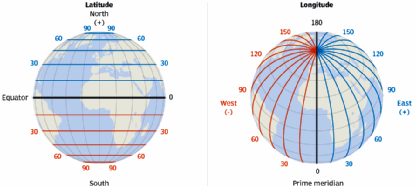Longitudes and latitudes are imaginary lines used to locate positions on the Earth’s surface.
- Latitude lines run horizontally (east-west) and measure the distance north or south of the equator, which is 0° latitude. The poles are located at 90° north (North Pole) and 90° south (South Pole).
- Longitude lines run vertically (north-south) and measure the distance east or west of the Prime Meridian, which is 0° longitude, located in Greenwich, England. The maximum longitude is 180° east or west.
Latitude and longitude are lines used to locate locations on planet earth.
Longitudes as from the Greenwich Meridian
It is a historic prime meridian or the Greenwich meridian used as a geographical reference line that passes through the Royal Observatory, Greenwich, in London, England and that passes from south to north pole of the earth.
The greenwich Meridian divides the earth into equal parts.
Because the earth is considered to be a circular sphere for the purpose of most of scientific studies, Greenwich Meridian is considered to pass through the center of the spherical earth dividing it into two hemispheres.
See the illustrations below:

Axis of the Earth
The axis of Earth is the imaginary line that is imagined to run from North Pole to South Pole through the center of the earth and believed
to be the line at which the earth rotate. It is imagined as the support the earth will have so that it is able to rotate at the 24 hours rotation
making one part face the sun and the earth be dark after every 12 hours.
The figure below illustrates the earth’s axis.

The line running on the Equator is usually referred to as the great circle because all the other circles besides it, to the right or left are smaller than it and are referred to as small circles. We are referring the lines as circles because they goes around the globe.
Note that the circles reduces in diameter as one moves from the equator towards the North or towards the South pole.
The Equator divides the circle into two hemispheres.
The equator is a circle perpendicular to axis of a spheroid, such as Earth, and dividing such a spheroid into two equal halves mostly refered to as north and south hemisphere.
see the illustrations below:

On Earth surface, the Equator is an imaginary line located at center of the earth and running from east to west and estimated to be about 40,075 km (24,901 mi) in length around the earth and lying halfway between the North and South poles.
The term equator can also be used for any other celestial body that is roughly spherical meaning we can find an equator in other planets of the universe and other bodies like moon.
In the sphere below, we illustrate an equator AB that divides the sphere into two equal parts. The circles on the south and the north of AB are both small circles and there are many circles that are drawn on either side of the equator AB known as the Latitudes.

Unlike the horizontal lines parallel to AB that changes in diameter relative to their distance from the equator; we have other lines that runs from south to north and each one of them have equal circumference and each one of them divides the globe into two equal parts. Because they are all equal in length and are greater than the equator, they are all regarded as great circles.
In the figure below, the lines are drawn that are parallel to PQ each one of them dividing the sphere into two. The radius R of each of the great circles is also the radius of the sphere.



Leave a Reply